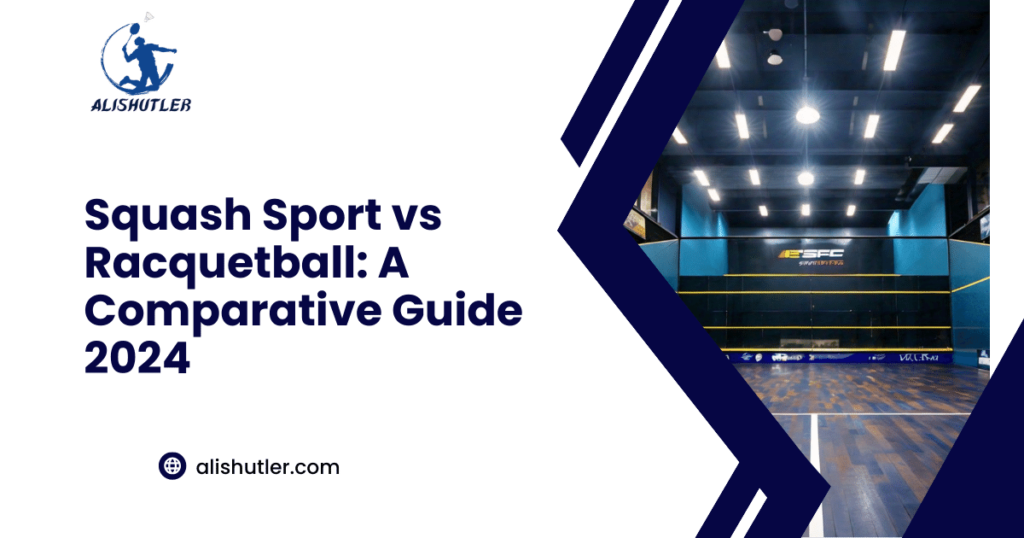Squash Sport vs racquetball, both indoor racket sports, offer players a high-energy workout while honing their agility and strategic skills. While squash sport demands precise shots in a confined space with a smaller, less bouncy ball, racquetball provides a faster-paced game on a larger court with a more resilient ball. Squash enthusiasts appreciate the finesse required for accurate shots and swift movements in tight quarters, whereas racquetball fans enjoy the speed and power-play opportunities on the bigger court. Whether you prefer the precision of squash or the rapid-fire action of racquetball, each sport presents unique challenges and rewards for players seeking an exhilarating athletic experience.
Key Takeaways
- Try Both Games: Experimenting with both squash and racquetball can help you determine which sport aligns better with your preferences and playing style. Understanding the subtle differences in court size, equipment, and rules can enhance your overall experience.
- Stay Informed: Familiarize yourself with the distinct rules and gameplay dynamics of squash and racquetball to fully appreciate the nuances of each sport. Being aware of these differences can not only improve your performance but also deepen your enjoyment of the game.
- Explore the Origins: Delve into the rich histories of squash and racquetball to gain a deeper appreciation for the evolution and development of these sports. Understanding their origins can provide valuable insights into their unique characteristics and playing styles.
- Consider Popularity: Take into account the popularity and appeal of squash and racquetball in your region or community. Choosing a sport with a strong following can offer more opportunities for practice, competition, and social engagement.
- Engage with Others: Connect with fellow players, coaches, or enthusiasts to exchange insights, tips, and experiences related to squash and racquetball. Building a network within the sports community can enhance your skills, motivation, and overall enjoyment of the game.
- Make an Informed Choice: When selecting between squash and racquetball as your preferred sport, weigh factors such as personal preference, physical abilities, competitive aspirations, and accessibility to facilities. Making an informed decision can lead to a more fulfilling and rewarding sporting experience.
Unveiling the Basics
Squash Sport Overview
Squash is a racquet sport played by two players (singles) or four players (doubles) in an enclosed court. The ceiling height in a squash court is typically around 20 feet, with a front wall measuring approximately 32 feet wide. Players use a small rubber ball, and the objective is to hit the ball against the front wall above the tin while outmaneuvering their opponents.
Racquetball Overview
Racquetball, on the other hand, is also played in an enclosed court but with some key differences. The ceiling in a racquetball court is lower compared to squash, usually around 20 feet high. The front wall in a racquetball court is shorter than that of squash, typically measuring about 20 feet wide. Players use a larger, faster ball in racquetball and aim to hit it against the front wall without letting it bounce twice.
Basic Rules and Objectives
In squash, players take turns hitting the ball against the front wall within certain boundaries and must alternate hitting the ball after each shot. The primary objective is to win points by forcing errors from the opponent or executing winning shots. On the other hand, racquetball follows similar principles of hitting the ball against the front wall but allows for more freedom in terms of shot selection due to different court dimensions and gameplay dynamics.
Court and Equipment Differences
Court Sizes
Squash courts are typically larger than racquetball courts, measuring about 32 feet long, 21 feet wide, and 15 feet high. On the other hand, racquetball courts are smaller, with dimensions around 40 feet long, 20 feet wide, and 20 feet high.
The key differences in court sizes play a crucial role in how each game is played. The compact nature of a racquetball court requires faster reflexes and agility compared to the more spacious squash court.
Racket Sizes and String Patterns
When it comes to racket sizes, squash rackets are longer and have a smaller head size compared to racquetball rackets. Squash rackets also tend to have denser string patterns for better control during shots.
The difference in racket sizes directly influences the player’s ability to generate power and maneuverability on the court. The unique string patterns in squash rackets provide players with enhanced precision and shot accuracy.
Equipment Characteristics
In squash, players use a small, hollow rubber ball that can be easily compressed upon impact. Conversely, racquetball employs a larger, bouncier ball made of solid rubber for increased speed and bounce off the walls.

The differences in equipment characteristics significantly affect gameplay dynamics. The compression of the squash ball demands strategic shot placement and control, while the faster pace of a racquetball game requires quick reactions due to the ball’s livelier bounce.
Rules of the Game
Scoring System
In racquetball, players earn points when they win rallies. A rally ends when a player fails to hit the ball before it bounces twice. Games are typically played to 15 points, with a minimum two-point lead required to win.
The scoring system in squash follows a point-a-rally format, where players can score points regardless of who served. The first player to reach nine points wins the game, but they must win by two clear points.
Key Differences
- In racquetball, players can serve from anywhere behind the short line, while in squash, serves must be made within specific service boxes.
- Squash is played in an enclosed court with four walls, whereas racquetball courts have three walls and an open side.
- Unlike racquetball, squash allows players to play the ball off any wall after hitting it.
- In racquetball, matches are usually best of three games, while squash matches can be best of three or five games.
Gameplay Dynamics
Speed and Bounce
In racquetball, the ball moves at a faster pace compared to squash due to its higher bounce off the walls. The speed and bounce in racquetball create a more dynamic and intense gameplay experience, requiring quick reflexes from players. On the other hand, in squash, the ball has lower bounce characteristics, leading to a strategic and controlled style of play.
Fitness and Skill Demands
Racquetball demands high levels of cardiovascular fitness and agility from players due to the rapid movements around the court. The fast-paced nature of racquetball requires players to have excellent endurance and quick decision-making skills. In contrast, squash emphasizes precision shots and technical skill, requiring players to exhibit finesse in their movements and shot placements.
Player Strategies and Tactics
In racquetball, players often employ aggressive tactics, utilizing the speed of the game to put pressure on their opponents. The fast-paced rallies in racquetball lead to quick exchanges and strategic shot selections to outmaneuver the opponent. Conversely, in squash, players focus on controlling the pace of the game through precise shots and strategic positioning on the court. Squash matches involve longer rallies that test both physical endurance and mental acuity.
- Racquetball
- Pros:
- Fast-paced gameplay
- Requires quick reflexes
- High-intensity workout
- Cons:
- Limited court movement space
- Higher risk of injuries due to speed
- Squash
- Pros:
- Emphasizes precision shots
- Strategic gameplay
- Tests mental acuity
- Cons:
- Lower bounce can be challenging for beginners
- Requires strong technical skills
Origins and History
Squash
Squash, a sport with ancient roots, originated in the 19th century at Harrow School in England. Initially played in narrow corridors, squash evolved into a popular indoor sport with international acclaim. The game’s fast-paced nature and strategic gameplay have attracted players worldwide.
Racquetball
In contrast, racquetball is a relatively modern sport that emerged in the mid-20th century in the United States. Joe Sobek, an American professional tennis and handball player, is credited with inventing racquetball in 1950. The sport gained rapid popularity due to its simplicity and accessibility.

Both squash and racquetball have undergone significant transformations over the years. Squash has transitioned from its humble beginnings as a recreational activity for students to becoming an Olympic sport recognized globally. On the other hand, racquetball has established itself as a dynamic alternative to traditional racket sports like tennis and badminton.
Milestones and Events
Throughout their histories, both sports have witnessed remarkable milestones and events that have shaped their trajectories. In 1904, the formation of the Men’s International Squash Rackets Federation laid the foundation for organized competitions and standardization of rules within the squash community. This pivotal moment elevated squash from a local pastime to a competitive sport on the world stage.
Similarly, racquetball experienced a surge in popularity during the 1970s when it was officially recognized by national sports organizations like USA Racquetball. The establishment of dedicated facilities and leagues further propelled racquetball into mainstream sports culture, attracting enthusiasts across different age groups.
The rivalry between squash and racquetball continues to fuel innovation and growth within each sport. While squash maintains its reputation as a sophisticated game requiring finesse and agility, racquetball appeals to players seeking fast-paced action and dynamic gameplay on enclosed courts.
Popularity and Appeal
Global Reach
Squash is a globally popular sport, played in over 185 countries, with a significant following in Europe, Asia, and North America. In contrast, racquetball is more prevalent in the United States and Canada, with a smaller presence worldwide.
Squash appeals to a diverse range of people, from amateurs to professionals, due to its fast-paced nature and strategic gameplay. On the other hand, racquetball attracts players looking for a dynamic sport that combines elements of power and precision.
Demographic Appeal
Squash’s appeal lies in its emphasis on agility, endurance, and mental acuity. It is favored by individuals seeking a comprehensive workout that challenges both the body and mind. The sport’s compact court size requires quick movements and sharp reflexes.
On the contrary, racquetball caters to those looking for an intense cardiovascular workout. Its larger court size allows for more extended rallies and emphasizes explosive movements. Players enjoy the adrenaline rush of rapid-fire exchanges close to the front wall.
Contributing Factors
The bounce characteristics of each sport contribute to their unique appeal. Squash, played with a small ball with less bounce, demands precise shots and strategic placement on the court. In comparison, racquetball, using a larger ball with more bounce, requires players to adapt quickly to varied shot trajectories.
Moreover, the fitness aspect plays a crucial role in attracting participants to both sports. Squash enthusiasts appreciate the high-intensity interval training it offers, burning up to 1000 calories per hour. Racquetball’s fast-paced nature ensures a full-body workout that enhances cardiovascular health.
Growth Potential
The size of the court also influences the sports’ popularity. Squash courts are typically smaller than racquetball courts, making them easier to construct in urban areas where space is limited. This accessibility contributes to squash’s growth in metropolitan regions around the world.
Squash vs Racquetball
Gameplay
Squash involves hitting a small, hollow rubber ball against the walls of a closed court using a long-handled racket. Racquetball, on the other hand, is played with a larger, bouncier ball in an enclosed court.

Players in squash aim to outmaneuver their opponents by strategically placing shots to make it difficult for them to return the ball. In racquetball, the emphasis is more on power and speed due to the faster pace of the game.
Rules
In squash, players take turns hitting the ball until one fails to make a good return. The ball can only bounce once before being hit back. Conversely, racquetball allows players to hit the ball after one bounce, leading to quicker exchanges and rallies.
Squash courts are typically smaller than racquetball courts, requiring players to be more agile and precise in their movements. Squash has stricter rules regarding where the ball can be hit on the front wall compared to racquetball.
Equipment
The equipment used in squash and racquetball differs primarily in terms of racket design and ball size. Squash rackets have longer handle and smaller heads compared to racquetball rackets. Squash balls are less bouncy and smaller than racquetballs, impacting the dynamics of gameplay significantly.
While both sports require agility and quick reflexes, squash demands more finesse and control due to the nature of the game. Racquetball, with its larger court space and faster-paced rallies, favors players with strong shot-making abilities and endurance.
Player Preferences
Individuals may gravitate towards squash for its strategic depth and emphasis on precision shots. The tactical nature of squash appeals to those who enjoy mentally challenging games that require careful planning and execution.
On the other hand, racquetball attracts players seeking fast-paced action and dynamic movement on the court. The adrenaline rush from rapid exchanges and powerful shots makes racquetball an exciting choice for those who thrive in high-energy environments.
Choosing Your Game
Preferences
Consider your preferences when choosing between squash and racquetball. If you enjoy a fast-paced game with quick rallies, racquetball might be your choice. On the other hand, if you prefer strategic gameplay with longer rallies, squash could be more appealing.
Physical Demands
Evaluate the physical demands of each sport before making a decision. Racquetball involves more lateral movement and sudden bursts of speed due to its larger court size. Squash, with its smaller court and emphasis on precision shots, requires players to cover short distances quickly.
Equipment
Compare the equipment needed for squash and racquetball. While both sports require a racket, the type of ball used differs. Squash balls are less bouncy than racquetballs, impacting the speed and style of play. Consider the grip size and weight of the rackets for comfort during gameplay.
Skill Development
Assess the skill development aspect of both sports. Squash focuses on shot accuracy, court positioning, and shot selection strategy. In contrast, racquetball emphasizes reflexes, agility, and quick decision-making due to its faster pace. Trying both sports can help you determine which skill set you enjoy honing.
Accessibility
Think about the accessibility of squash and racquetball facilities in your area. Consider factors such as court availability, membership costs, coaching services, and community engagement opportunities for each sport. Accessibility plays a significant role in how often you can practice and improve your game.
Final Remarks on Squash Sport vs Racquetball
Now that you’ve go through into the distinctions between squash sport vs racquetball, you’re equipped with the knowledge to make an informed decision about which game suits your preferences best. Understanding the court variances, equipment specifics, gameplay dynamics, and historical backgrounds of both sports can aid you in choosing the game that resonates most with your interests and skills.
Before you grab your racket or paddle, take a moment to reflect on what aspects of each sport appeal to you the most. Whether it’s the fast-paced nature of racquetball or the strategic gameplay of squash, selecting a sport that aligns with your strengths and passions will undoubtedly enhance your overall experience on the court. So, go ahead, pick your game, and enjoy the exhilarating world of squash or racquetball!
Frequently Asked Questions
What are the key differences between squash sport and racquetball?
Squash is played in a four-walled court with a smaller, harder ball using a closed racket. Racquetball uses a larger, bouncier ball on a three-walled court with stringed rackets. Squash involves more strategy due to its smaller court size.
Which game, squash or racquetball, is more physically demanding?
Squash is generally considered more physically demanding than racquetball due to the smaller court size, faster pace of play, and greater emphasis on movement and agility.
What are the basic rules of squash and racquetball?
In squash, players take turns hitting the ball against the front wall above the tin without it bouncing twice. In racquetball, players must hit the ball before it bounces twice while aiming for the front wall.
How do the origins and histories of squash and racquetball differ?
Squash originated in England in the 19th century as a variation of rackets. Racquetball was developed in the United States in the 1950s as an alternative to squash with different rules and equipment.
Which game, squash or racquetball, has a higher level of popularity globally?
Squash has a larger global following compared to racquetball, with professional tours, international competitions like the World Championships, and widespread participation across various countries.



